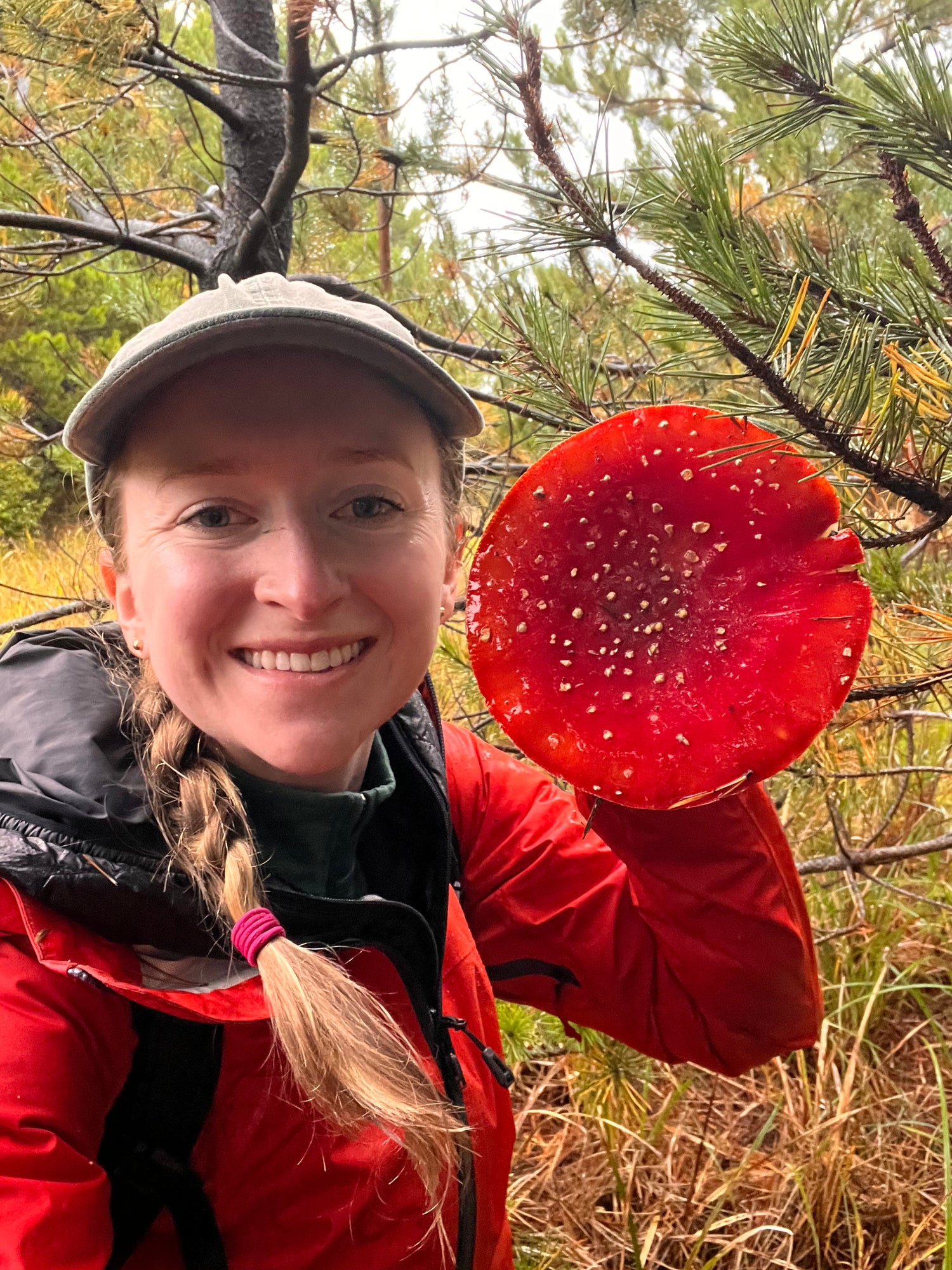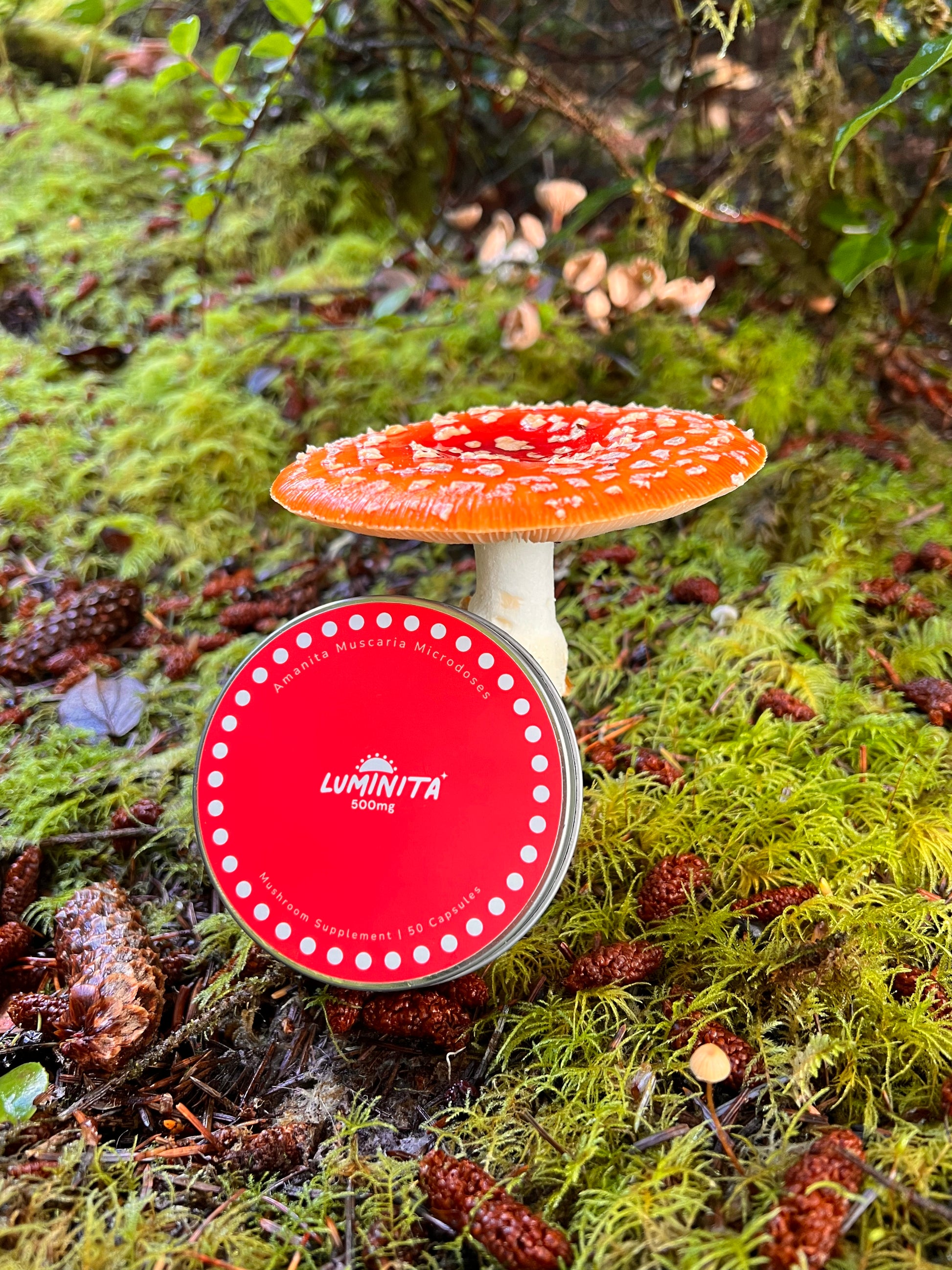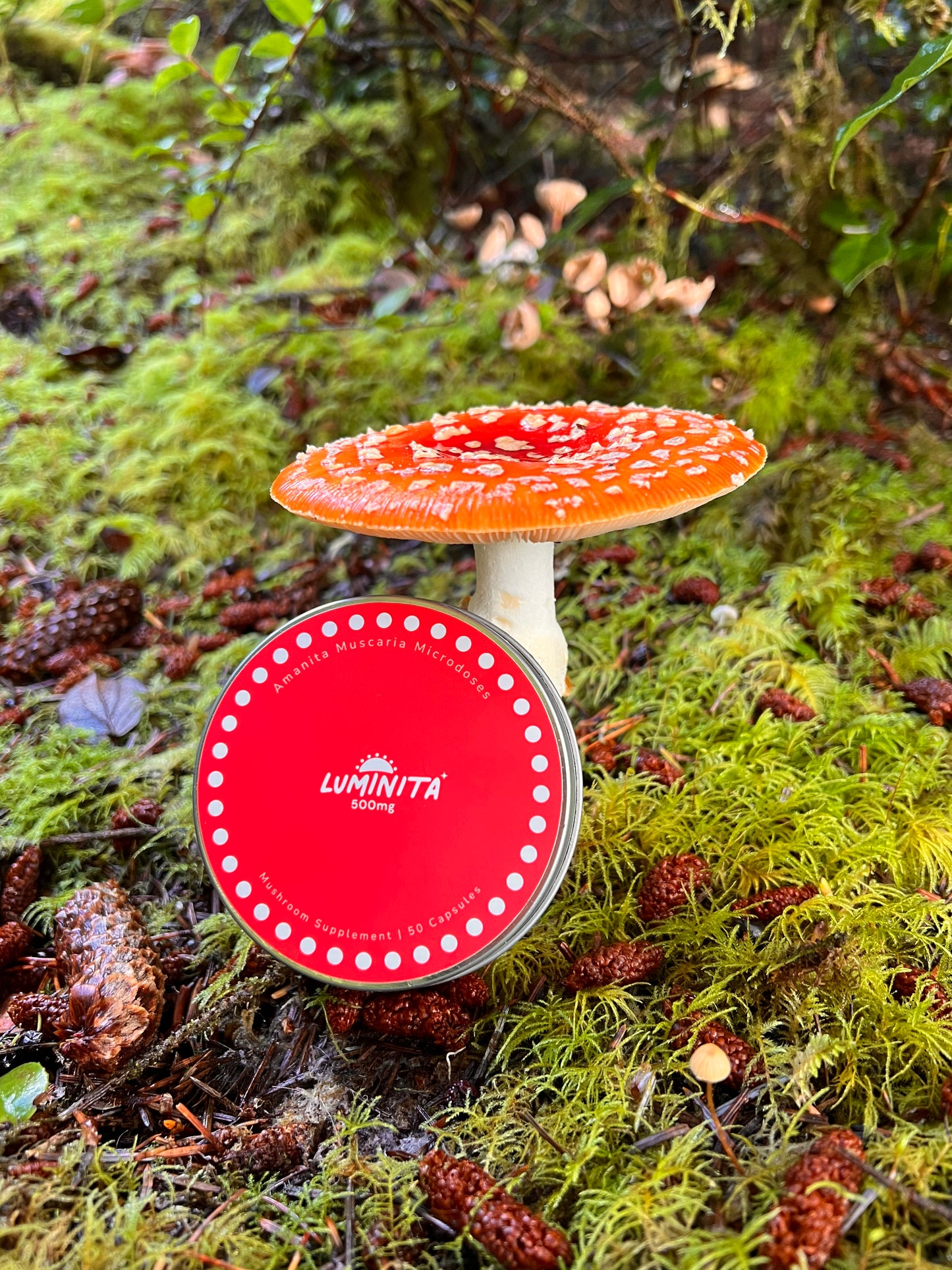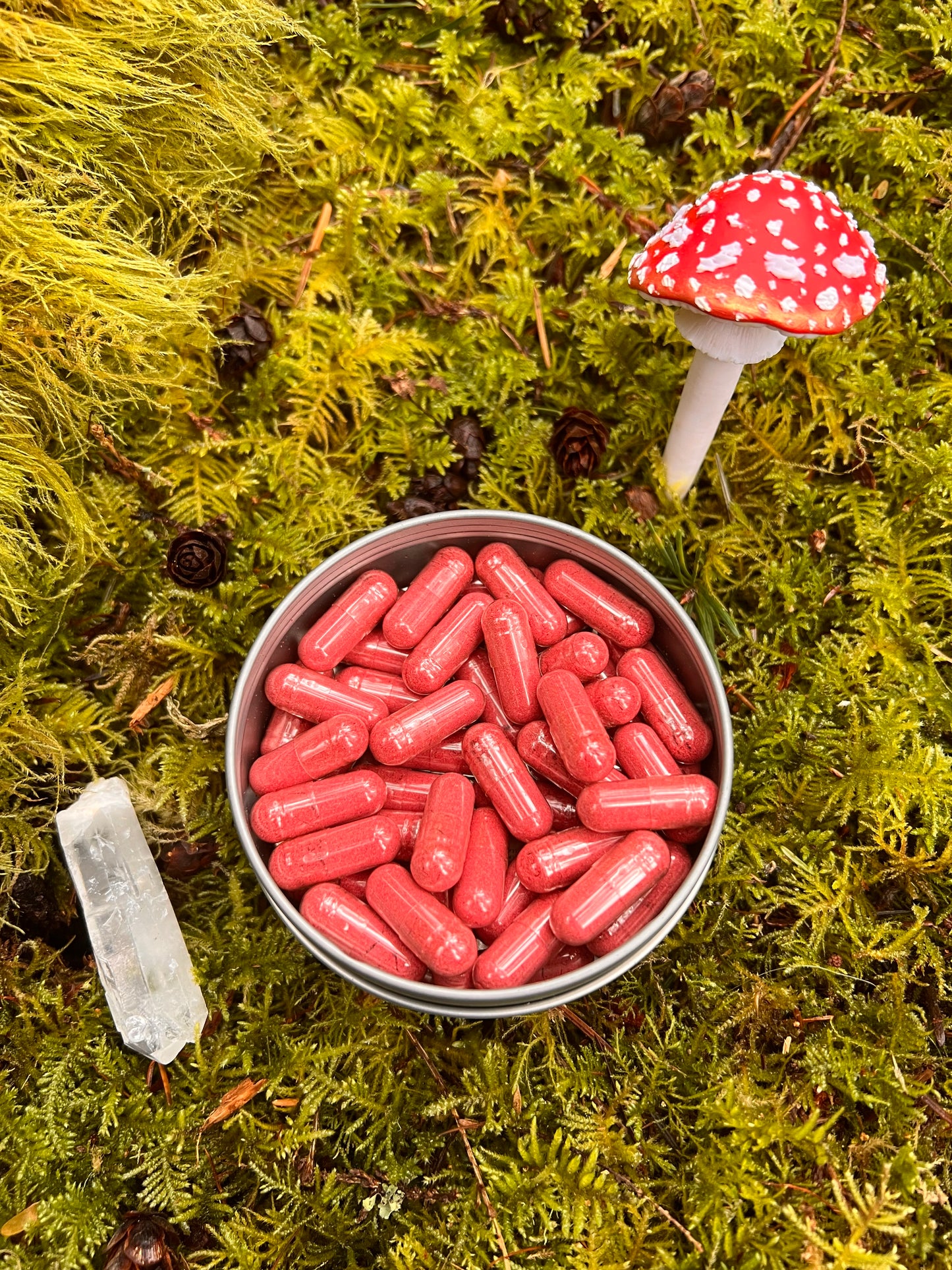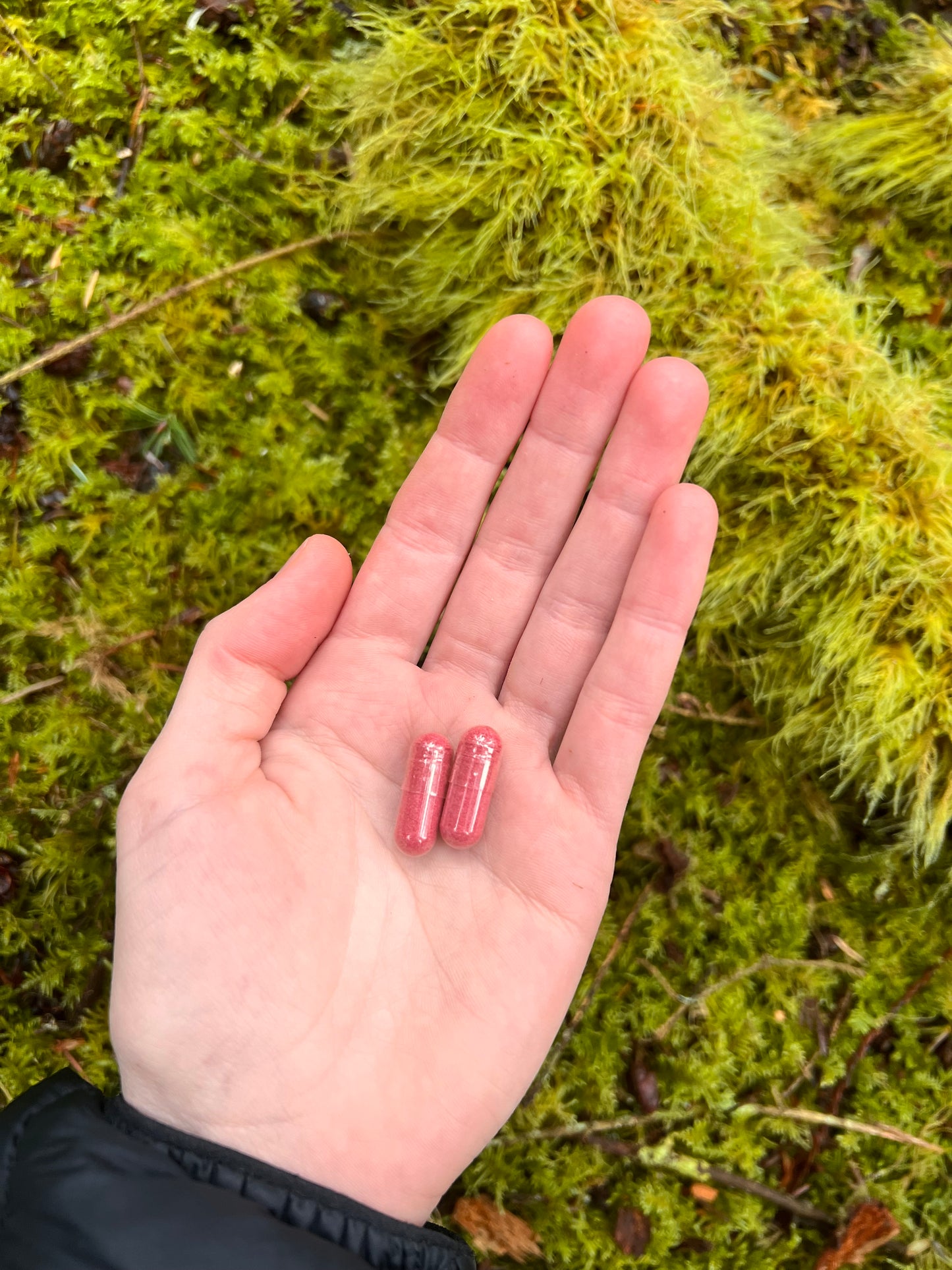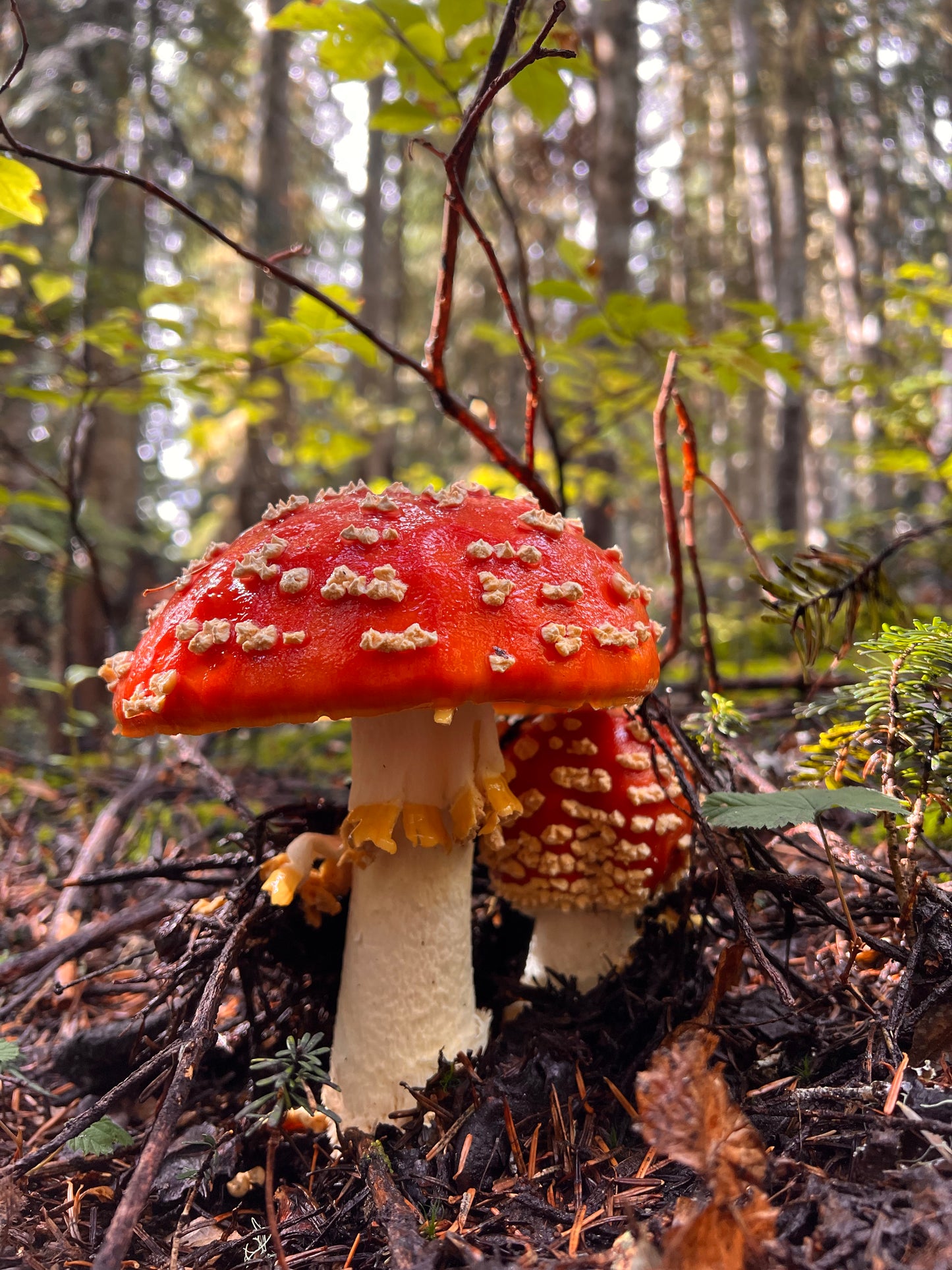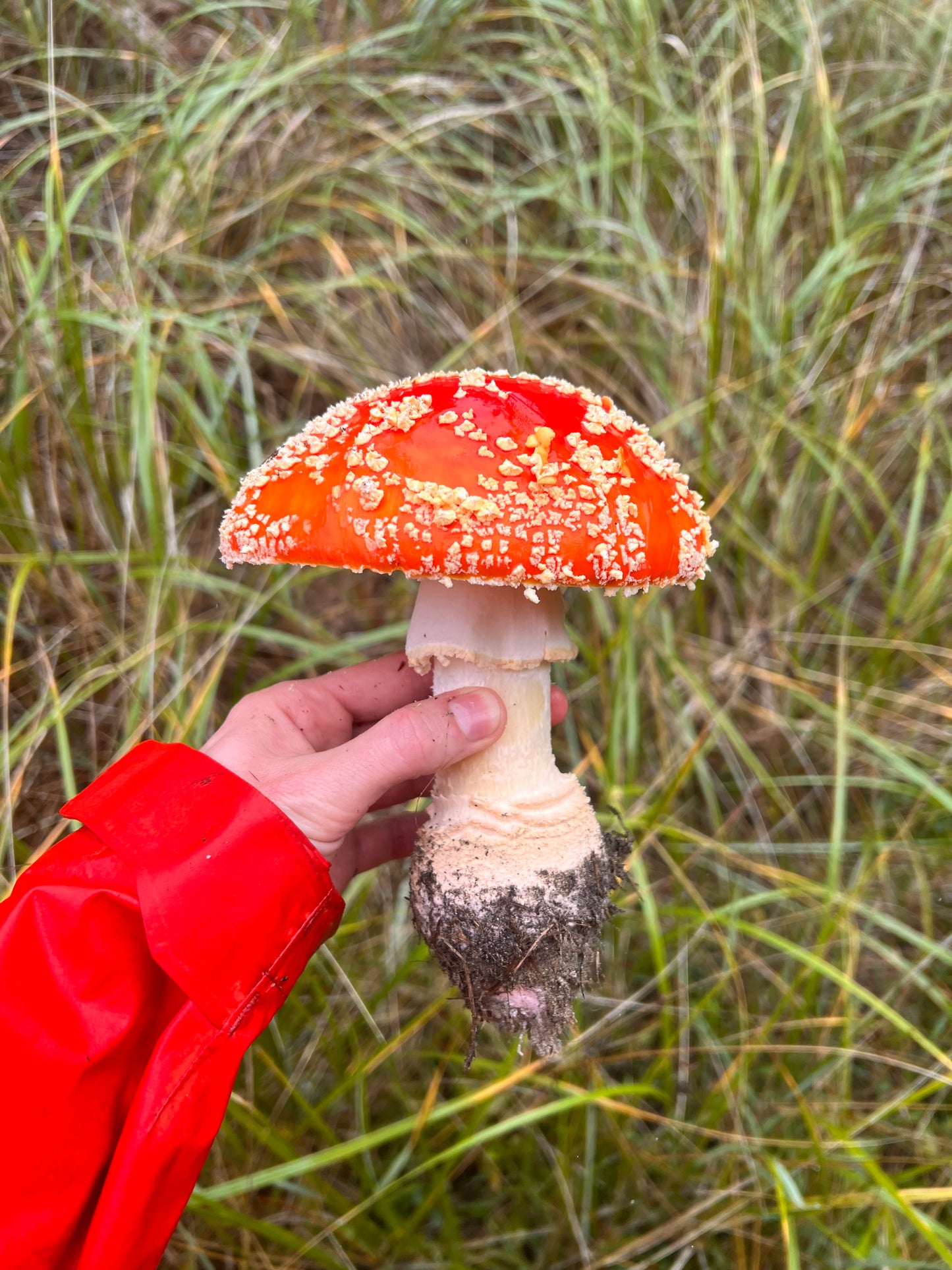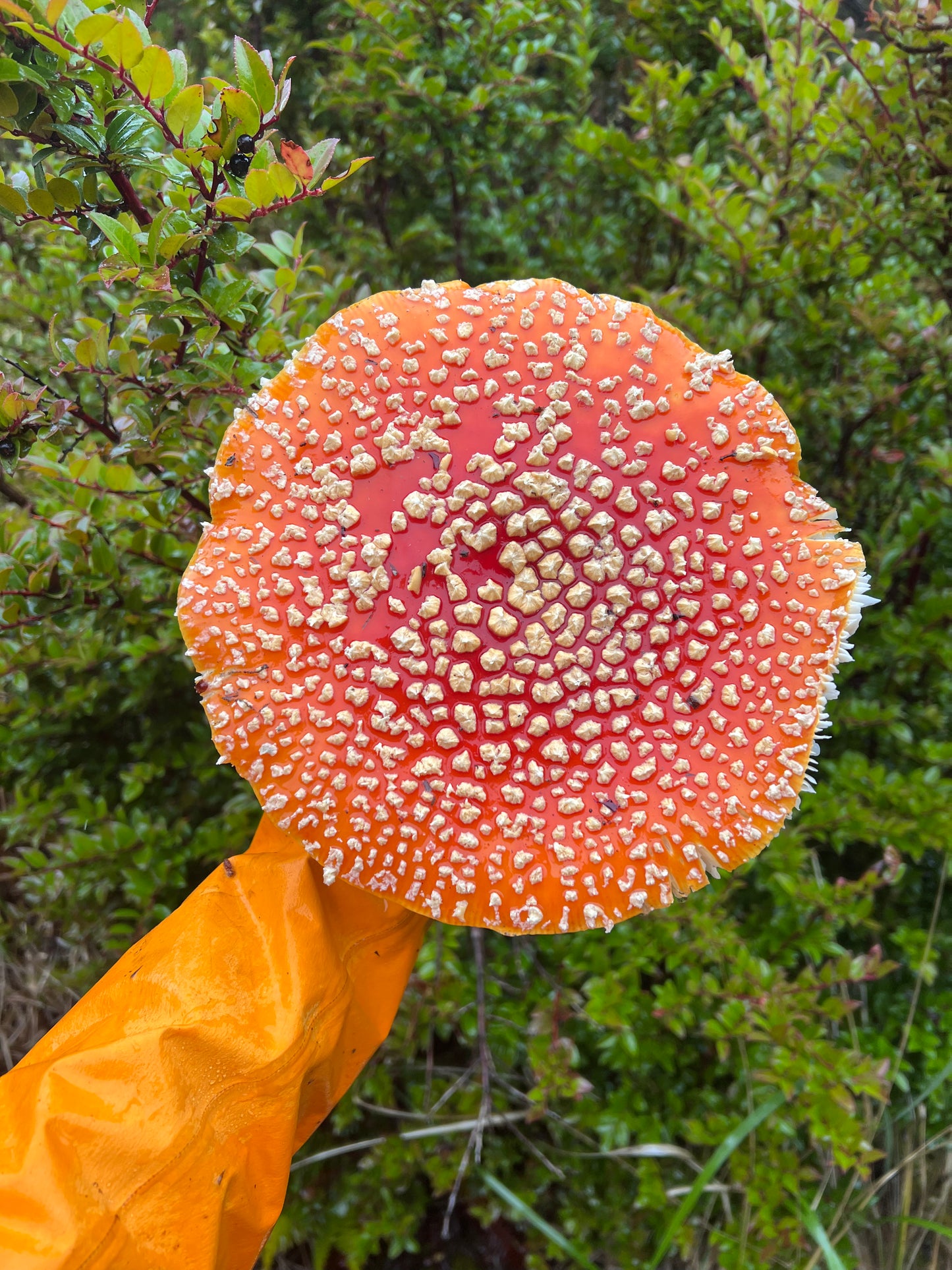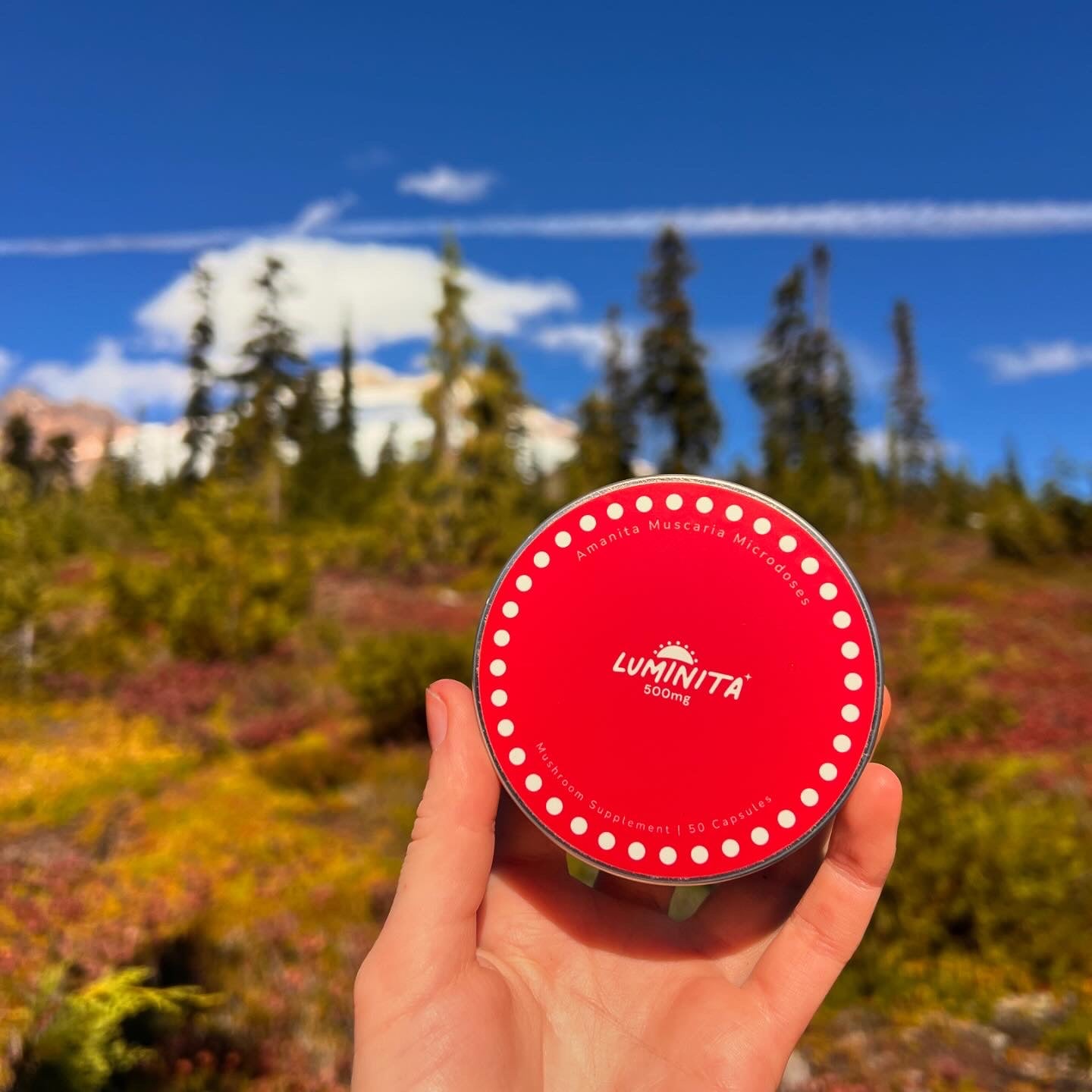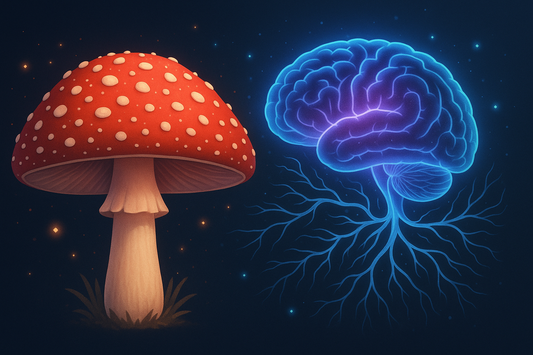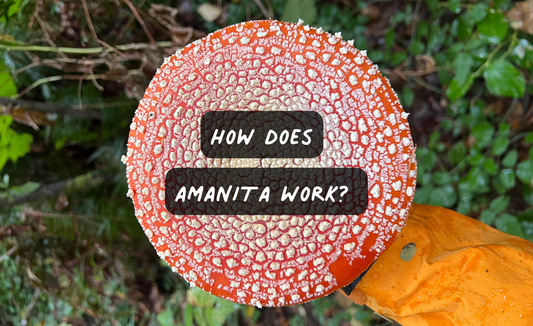Journal Contents
- Intro
- The Healing Power of Amanita Muscaria
- What is Muscimol
- What is GABA?
- How does Muscimol Act on the GABAa Receptor?
- How Does Muscimol Calm the Brain?
- How Does Muscimol Reduce Stress?
- How Does Muscimol Change Our Brainwave State?
- How to Microdose Muscimol?
- Conclusion
Reading Time: 15 min
Tags: Neurochemistry, Microdosing, Safety, Pharmacology, Brainwaves
Intro
Amanita muscaria is one of the most misunderstood mushrooms in the world. While most people can recognize it’s vibrant red and white cap, few know the name Amanita muscaria, and even fewer know it contains muscimol, an active molecule that interacts with GABA neurotransmitters in the human brain to deliver unique calming, grounding & mood boosting effects.
In this article, we’ll separate myth from science to explain exactly how muscimol works, how it calms the fight or flight system and how microdosing Amanita muscaria can help you balance your own nervous system.

The Unique Benefits of Amanita Muscaria
- Emotional regulation
- Calming and grounding the nervous system
- Reducing social anxiety and intrusive thoughts
- Improving focus and mental clarity
- Reducing insomnia & sleep issues
- Increasing confidence
- Improving motivation and fear
- Lowering pain
- Improving mood and reducing suicidal ideation
In general it seems Amanita muscaria has a broad calming and uplifting effect on our mental, spiritual and physical body.
Read: Benefits of Microdosing Amanita Muscaria
But How Does Amanita muscaria bring about these effects?
Pharmacognosy is similar to the study of pharmacology, which looks at the activity of drugs, but instead relates to plant medicines.
By narrowing our focus to the chemical and neurotransmitter level, we can:
- Understand how Amanita’s main bioactive compounds affect our brain and nervous system
- Determine the best ways to process and treat the mushroom.
- Predict drug interactions that may be harmful to combine with Amanita muscaria
- Open up opportunities for further research into Amanita
What is Muscimol?
Though plants and fungi contain many active compounds, there often exists one main molecule that makes up the majority of its psychoactive effects. You can think of these compounds as the “essence” of the plant medicine.

What About Ibotenic Acid?
If you’ve read up on amanita muscaria at all, you’ve probably heard about ibotenic acid being another main component of the mushroom. This is true. In fact Ibotenic is found in much higher amounts in the raw mushroom. However, ibotenic acid is merely a prodrug (or precursor) of muscimol, meaning it is easily broken down into muscimol via decarboxylation. (Read: What is Decarboxylation and Why Does it Matter?)
Scientists have determined that most of amanita’s beneficial effects come from muscimol, and not ibotenic acid. For the purpose of this article, we will focus solely on muscimol.
Muscimol vs GABA
In 1969, researchers from Italy identified that muscimol’s psychoactive effects came from its action on our GABA neurotransmitter system.
 Due to their similarity, muscimol acts in very much the same way as our own GABA neurotransmitters. It binds easily to GABA receptors and activates the system in a very similar way.
Due to their similarity, muscimol acts in very much the same way as our own GABA neurotransmitters. It binds easily to GABA receptors and activates the system in a very similar way.This was a huge discovery as scientists could now use muscimol as a study drug in place of GABA.
GABA, although easily synthesized, is not able to cross the blood brain barrier - the layer of cells that protects the brain from the rest of the body. This makes it very difficult to study because it’s not active in the body (unless it’s injected directly into the brain).
Fun fact: it’s also the reason those GABA supplements that you picked up at Trader Joe’s don't work all too well.
Muscimol, on the other hand, is able to cross the blood brain barrier. Because of this and the fact that its effects very similar to GABA, it is commonly used by the scientific community to better understand the GABA system. In fact, there are currently over 52,000 papers that reference muscimol on Google scholar. No small stack of papers.
So ,although many claim that there isn’t much research on Amanita mascaria, there is more than plenty on the molecule that makes up the essence of the mushroom.
TL,DR: Muscimol is the main active compound found in Amanita muscaria mushrooms. It is able to cross the blood brain barrier which makes it a very common study drug for the GABA system, allowing us access to solid research on the benefits and neurochemistry of muscimol.
What is GABA?
GABA or gamma-aminobutyric acid is the main inhibitory neurotransmitter in the brain and nervous system. It is one of the most common neurotransmitters, being found within the central nervous system (CNS), peripheral nervous system (PNS) and the gut.
Neurotransmitters: Chemical messengers that transmit signals between 2 neurons. They are essential for communication within in the nervous system. They can be excitatory, inhibitory or modulatory.
- Dopamine – reward, motivation, and pleasure.
- Serotonin – mood, empathy and contentment.
- Acetylcholine – attention, clarity and muscle activation.
- Norepinephrine: alertness, arousal, and fight or flight response
- Glutamate – “the gas pedal”, learning, memory and expanded awareness
- GABA: “the break pedal” calm, inner peace and meditative awareness
GABA reduces neuronal excitability by binding to specific receptors, primarily the GABA-a receptor, located at the synaptic cleft, the gap between 2 neurons.

GABA in the Synaptic Cleft
The GABA-a receptor is not just a receptor with a lock and key function, it’s actually a channel into the cell.
Once activated, the GABA-a receptor opens up and allows chloride ions (Cl-) to flow into the neuron. The more negative ions, like chloride, enter the neuron, the lower the overall membrane potential of that cell is and the less likely that neuron is to fire.
The GABA Neurotransmitter is All About balance
The proper functioning of the CNS depends on the balance between the excitatory and inhibitory neurotransmitters.
GABA’s role is to reduce the firing rate of overactive neurons. When multiple neurons across the brain are inhibited, it reduces activity and promotes a calm headspace. This in turn brings the body into a state of balance.
Think of GABA like the “break pedal”. It slows down the nervous system when it’s going a little too fast. Without a properly functioning GABA system, neurons can get overexcited. This can lead to feelings of stress, anxiety, fear, insomnia or in a very imbalanced system: seizures.
Remember: the human body always wants to be in a state of balance. Homeostasis is the backbone to a healthy and well functioning system. GABA is essential for this balance.
Because of GABA’s unique role as the inhibitory system, it is involved in regulating many parts of our nervous systems like:
- Neuronal activity
- Anxiety & stress
- Sleep
- Pain
- Hormonal Release
- Gastrointestinal Function
- Emotional Responses
- Cognitive Function
- Immune System
- Appetite and Eating Behavior
- Motor Control

How Does Muscimol Act on the GABA-a Receptor?
You may be wondering, if all these drugs act on the same receptor, how do they each have such different effects?
The GABA-a receptor, like other receptors, actually has multiple binding sites. Binding sites are basically the different locations on the outside of the neurons receptor where a molecule can bind.

GABAa receptor [Lumen Learning]
Orthosteric site: The primary binding site where the body’s natural ligand binds to activate the receptor. It’s like a “keyhole”, only the right key (GABA or muscimol) can trigger its function.
Allosteric Site: Secondary binding sites on a receptor where molecules bind to modulate the receptor’s activity indirectly. It acts like a “dimmer switch,” enhancing or reducing the receptor’s response without directly activating it.

How Does Muscimol Calm the Brain?
Muscimol binds to GABA-a receptors throughout the Central Nervous System.
The central nervous system (CNS) is found in the brain & spinal cord. it is responsible for processing every thought, movement, and sensation in the human body. The CNS acts as the body’s command center, coordinating functions like breathing, muscle movement, memory, and emotional responses.
Unlike GABA, which is rapidly cleared from the synaptic cleft, muscimol has a longer-lasting effect. This prolonged activation can suppress excessive neuronal firing across various brain regions, including the cortex, thalamus, and limbic system, contributing to its psychoactive properties.

Some of mucimol’s major affects to different brain regions include:
- Quieting The Amygdala: The amygdala is considered the fear center of the brain. Muscimol inhibits neurons in this region, easing stress, anxiety, and fear. At low doses this gives a boost of confidence, while at high doses it can cause abnormally brave behavior (anyone up for a Viking conquest?)
- Reducing Hippocampus Activity: The hippocampus is the area of the brain connected to memory and emotions. Muscimol reduces the intensity of emotional memory recall which is the key to reducing intrusive thoughts and strong emotions. The hippocampus is also connected to the fight or flight system, and muscimol’s inhibitory action allows the body to move into a state of “rest & digest” - more on this later (Müller et al., 2024).
- Calming the Thalamus: The thalamus is the part of the brain that filters sensory inputs from the environment. Muscimol calms this brain region. In small doses this helps minimize sensory overload & increase focus, while in high doses it can cause dissociation or even a coma-like sleep. (Benkherouf et al., 2019).
- Regulating the Sleep-Wake Cycles in the Hypothalamus: Muscimol enhances GABA activity in the hypothalamus, the brain region responsible for driving wakefulness through histamines and cortisol. By inhibiting wake-promoting neurons and reducing cortisol, muscimol allows for a faster sleep onset and better rest. (Johnston, 2014).
- Reducing Glial Cell Neuroinflammation: Glial cells, the CNS’s immune cells, may become overactive when the body is under stress for a long period of time. Muscimol helps calm these cells and low doses may help ease pain, muscle tension and any mood issues that are linked to inflammation. (Chandra et al., 2010).
- Loosening Cerebellum Control: The Cerebellum control’s the body’s balance, coordination and timing. Low doses of muscimol loosen the muscles and add a “floaty” sensation to movements. High doses cause a loss of balance, slurred speech and difficulty control bodily movements. (Burgess, 2013)
Think of muscimol as a dimmer switch for your brain’s stress signals.
- Lower doses (like microdosing) has a balancing effect on the brain. It helps reduce excessive stimuli, stress and overthinking to help you feel calmer and more grounded.
- Higher doses can cause sedation, loss of coordination and dream-like states. This is due to stronger and more widespread CNS inhibition.
Summary: Muscimol calms the CNS by activating GABA-A receptors, reducing neural excitability in the brain and spinal cord. Lower doses quiet stress, anxiety, overthinking and tension, while higher doses cause sleepiness, loss of coordination and dissociation.
How Does Muscimol Reduce Stress?
- Common Name: Fight or Flight system
- Main role: prepare the body for action in times of stress or danger.
- When active: heart rate increases, breath rate shortens, the immune system is suppressed, digestion slows and cortisol increases to prepare for the emergency.
- Common Name: Rest and Digest -or- Healing and Recovery System
- Main role: heal and repair body in times of calm and safety.
- When active: heart rate slows, breath rate slows, immune system is activated, digestion increases, cortisol decreases, inflammation decreases, sleep quality improves, hormones balance
What’s interesting about these two programs is that they inhibit one another. So if you are in the “fight or flight system” the parts of the body that function with the “rest and ingest system are inhibited until you are in a safe place again.
Muscimol Inhibits the Fight or Flight System
- blood pressure decreases
- breathing slows down
- digestion becomes more efficient
- inflammation reduces
- hormones balance
- sleep quality improves.
How Does Muscimol Change our Brainwave State?
Because muscimol activates many GABAa receptors throughout the central nervous system, its inhibitory effects have a measurable effect on our brainwave state.
Brainwave states are measurable electrical patterns in the brain that reflect neural activity. They are like radio frequencies, with each a different mental channel.
Brainwave patterns are categorized by frequency bands (delta, theta, alpha, beta, gamma). Each band is distinct, and represents different cognitive functions, with low brain activity being tied to daydreaming & sleep and high activity being tied to problem solving & alertness.

The exact brainwave states muscimol induces is highly dependent on the dose. Unlike psychedelics (like psilocybin) which increase gamma activity and neural connectivity, muscimol reduces brainwave activity. This has a slowing effect, akin to sedatives like benzodiazepines and alcohol but with unique psychoactive qualities.
- At Low Doses, muscimol promotes alpha waves (often called the flow state). These states are associated with relaxation, meditation and lucid awareness. This is the mental space microdosing Amanita can support you with. You are able to be drive and go to work, but you have a much more calm, and meditative headspace.
- At Moderate Doses, muscimol promotes theta waves. These states are associated with deep relaxation, daydreaming and sleep. This is akin to having 1-2 glasses of wine. You are disinhibited, can think creatively and can fall asleep easily.
- At High Doses, muscimol promotes delta waves. Widespread inhibition of brain activity leads to impaired motor coordination, deep (coma-like) sleep and intense dream-like hallucinations. This would be like a heroic dose of Amanita, not to be messed with and not very enjoyable.
TL,DR: Low doses of muscimol are where we see the most benefit for our day to day lives. This relaxed alpha state allows for presence, clear thinking, creativity, and emotional balance without the mental chatterbox, negative thoughts, and stress associates with higher brainwaves. When we are in the alpha state we are in a balanced state of meditative flow.
How to Microdose Muscimol
As you can see, muscimol is a very powerful molecule that can cause very different effects depending on how much is consumed. muscimol (& Amanita Muscaria) offers a gentle way to harness the mushroom’s calming and balancing effects without the intense sedation or dissociation associated with higher doses.
How Much is a Microdose?
A microdose of Amanita muscaria is typically 0.2–1g of dried, decarboxylated mushroom, taken 1–3 times per week. This delivers a subtle dose of muscimol (approximately 1–5mg - depending on potency) to promote calm focus, stress relief, and better sleep.
Dosing Guidelines:
- Dosage: Begin with 0.2–0.5g of properly prepared (decarboxylated) Amanita muscaria, taken daily. Adjust based on your body’s response. *Most people microdose between 0.2-1g daily.
- Frequency: Take daily for 3 weeks, then 1 week off to evaluate effects (aligned with your other article’s protocol).
- Timing: Take in the morning for focus or evening for sleep support, depending on your goals.
- Storage: Keep your micro doses in the fridge or freezer and use within 6 months to prevent the natural degradation of muscimol.
Preparation Matters: Always use decarboxylated Amanita to minimize ibotenic acid, which can cause nausea. Homogenize mushrooms for consistent potency (link: Decarboxylation Guide).
Safety Tips:
- Use high-quality, wild-foraged, clean and lab-tested products to ensure purity and potency. I recommend Luminita’s Wild Foraged Amanita Muscaria Microdoses.
- Avoid combining with alcohol, benzodiazepines, opiates or other GABAergic drugs to prevent excessive sedation. Consult a doctor if you have pre-existing conditions or are on medication.
- Ensure the mushroom is dried and decarboxylated to convert ibotenic acid to muscimol, reducing potential side effects like nausea.
Microdosing Amanita Muscaria is ideal for those seeking a natural way to manage stress, improve sleep, or enhance mental clarity without the intensity of psychedelics or the side effects of pharmaceuticals. t’s not a one-size-fits-all solution, but its unique ability to work with your body’s GABA system and bring balance to the nervous system makes it a powerful tool for wellness.
Read: How to Microdose Amanita muscaria
TL,DR: Most people see benefits when microdosing between 0.2-1g of decarboxylated dried Amanita muscaria mushroom or between 2-10mg of pure muscimol. You can take it in the morning or evening, depending on your goals and can store it in the freezer when not in use.
Conclusion
From its vibrant cap to its profound effects, Amanita muscaria and its star compound, muscimol, offer a remarkable bridge between nature and neuroscience. By activating the GABA-a receptor, muscimol quiets the mind’s chatter, shifts brainwaves into meditative alpha states, and calms the fight-or-flight response, fostering a state where the body can heal.
In a world where pharmacists and nutritionists have sought to modulate or replicate GABA’s activity in the brain, Mother Nature has given us an answer. Muscimol, unlike GABA and other GABAergic drugs, is able to cross the blood brain barrier and bind to our endogenous receptor sites, putting our bodies into a state of balance and inner peace.
Most importantly muscimol is a widely accessible (and insurance-free) medicine that is readily produced from one of the most beautiful mushrooms known to man.
Whether you’re seeking clarity, restful sleep, or emotional balance, microdosing this mushroom can align your body’s natural rhythms in a world that often feels out of sync.
Interested in trying Amanita muscaria for yourself? Try my Wild Foraged Amanita Muscaria Microdoses
References
- Johnston, G. A. R. (2014). Muscimol as an Ionotropic GABA Receptor Agonist. Neurochemical Research, 39(10), 1942–1947. https://link.springer.com/article/10.1007/s11064-014-1245-y
- Chandra, D., Halonen, L. M., Linden, A.-M., Procaccini, C., Hellsten, K., Homanics, G. E., & Korpi, E. R. (2010). Prototypic GABA_A Receptor Agonist Muscimol Acts Preferentially Through Forebrain High-Affinity Binding Sites. Neuropsychopharmacology, 35(4), 999–1007. https://www.nature.com/articles/npp2009166
- Benkherouf, A. Y., Taina, K. R., Meera, P., & Uusi-Oukari, M. (2019). Extrasynaptic δ-GABA_A Receptors Are High-Affinity Muscimol Receptors. Journal of Neurochemistry, 149(6), 672–684. https://onlinelibrary.wiley.com/doi/10.1111/jnc.14646
- Müller, V., Ernst, M., Baykuchkarova, A., Koniuszewski, F., Bampali, K., Seidel, T., & Scholze, P. (2024). Probes for the Heterogeneity of Muscimol Binding Sites in Rat Brain. Frontiers in Pharmacology, 15, 1350661. https://www.frontiersin.org/articles/10.3389/fphar.2024.1350661/full
- Arnt, J., Scheel-Krüger, J., Magelund, G., & Krogsgaard-Larsen, P. (1979). Muscimol and Related GABA Receptor Agonists: The Potency of GABAergic Drugs In Vivo Determined After Intranigral Injection. Journal of Pharmacy and Pharmacology, 31(1), 306–313. https://academic.oup.com/jpp/article-abstract/31/1/306/6184817
- Snodgrass, S. R. (1978). Use of 3H-Muscimol for GABA Receptor Studies. Nature, 273(5660), 392–394. https://www.nature.com/articles/273392a0
- Akinshola, B. E., Stewart, R. R., & Desai, M. (2007). Substance Use Disorders: A 2007 Study Found That Muscimol Reduced Cocaine Self-Administration. https://en.wikipedia.org/wiki/Muscimol
- Lyden, P. D., & Lonzo, L. (1994). Combination of Muscimol and Dizocilpine Provides Enhanced Neuroprotective Efficacy. Cited in ScienceDirect Topics: Muscimol. https://www.sciencedirect.com/topics/neuroscience/muscimol
- Brehm, L., Hjeds, H., & Krogsgaard-Larsen, P. (1972). “The structure of muscimol, a GABA analogue of restricted conformation.” Acta Chemica Scandinavica, 26, 1298–1299.
- Scotti de Carolis, A., Lipparini, F., & Longo, V. G. (1969). “Neuropharmacological investigations on muscimol, a psychotropic drug extracted from Amanita muscaria.” Psychopharmacologia, 15, 186–195.
-
Burgess, C. R., et al. (2013). Cerebellar Purkinje cell activity modulates rhythmic licking behavior in mice. eLife, 2, e00518. https://doi.org/10.7554/eLife.00518
Demonstrates how muscimol-induced inhibition in cerebellar regions affects rhythmic motor coordination.


